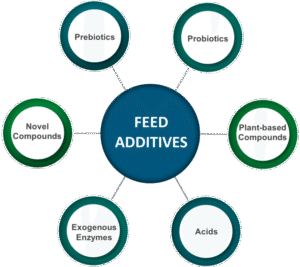The assessment of amino acid requirement is an ongoing topic with
overwhelming importance for the livestock industry. Dietary supply of
nutrients like amino acids to meet animals` requirements directly impacts
on the economic bottom line of operations. It is well known that
imbalances in dietary amino acids profiles result in reduced growth
rate and feed efficiency. In addition, amino acid deficiencies could
impair the animals` immune function. Diets formulated with balanced
amino acid profile will help to reduce nitrogen losses in animal manure
and result in environmental benefits. Amino acids requirements
are influenced by many factors, e.g. animal species and breed, age,
gender, physical activity, body protein accretion level, health status
and others. In general, requirements can be assessed in-vivo with
various trial techniques, measuring animal responses to changes
in dietary amino acid supply. Differences in techniques and statistical
data evaluation may lead to different requirement figures. Amino
acid requirements are listed for major animal species in requirement
tables, which are published by different scientific bodies like NRC
(USA), CVB (The Netherlands), GfE (Germany), INRA (France) or
FEDNA (Spain). These tables are kept to meet the respective current
scientific level.
The indication of amino acid requirements, where possible on a digestible
basis, is mostly expressed as dietary concentration, and in
some cases as per animal and per day. Requirement data for minor
but essential amino acids are not always available across the covered
species. In such cases, the figures have been calculated based
on ideal amino acid profiles. However, ideal profiles are not available
for all species and in such cases requirement figures are given for
selected amino acids only. In summary, considering all the options available as alternative nutritional
strategies, amino acid supplementation offers the following benefits:
— Cost efficient amino acid supply
— Reduction of dietary crude protein content
— Decrease of N-excretion and environmental N-load
— Prevention of digestive disorders
— Improved energy utilization
— Providing higher amino acid availability compared with protein
bound amino acids
— Balancing of amino acid variations in feed ingredients
— Allowing for high dietary nutrient density
Therefore using amino acids in compound feed formulation ensures
optimum weight gain associated with high feed efficiency and low
production cost. Amino acid supplementation allows realization of the
full genetic growth potential
This booklet sums up amino acid requirement information based on
literature and industry research and is meant as recommendation for
nutritionists or other interested parties.
8.1. Broilers
Many diverse factors are considered when estimating nutrient requirements.
Researchers and national councils in different countries have
stipulated different optimum levels of energy contents for broiler finishing
diets. Furthermore, the composition of feeds used in the growing
stages and their period of application are influenced by availability
of raw materials in different countries. Finally the weight when the bird
is slaughtered is influenced by variation in consumer demand.
Ration formulation must also account for the changing voluntary intake
of the bird as intake is reduced in response to the high energy
concentration of poultry finishing diets. The amino acid concentration
of the diet must be increased in order that the absolute intake
of amino acids does not fall. The recommended amino acid profile
changes with the age of the bird, which is generally divided into three phases, as given in Table 13. Based on this profile, recommendations
for the true digestible amino acid content for broilers’ diet is given in
Table 14 for standard levels of energy.
Only the proportion of amino acids that can be digested and absorbed
from feed protein is made available for metabolism, the remainder is
eliminated as part of the faeces. The digestibility of amino acids can
differ between different raw materials even though the ingredients
may have the same amino acid content. Thus ingredients may differ
markedly in their “value” as an amino acid supplier to the organism.
In order to account for these differences in amino acid digestibility
there has been a tendency for recommendations of amino acid requirements
to be made on the basis of digestible amino acids which
increases the precision of formulation of the amino acid requirements
of the bird
Thank you for reading. Don't forget to subscribe & share!









